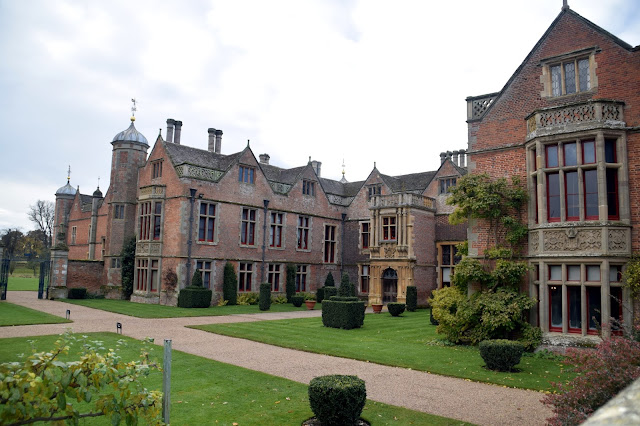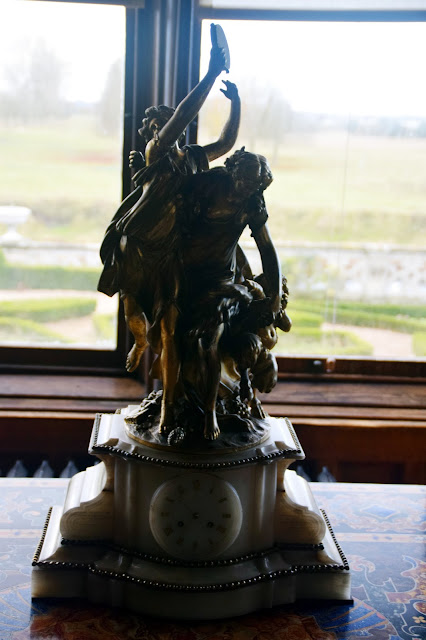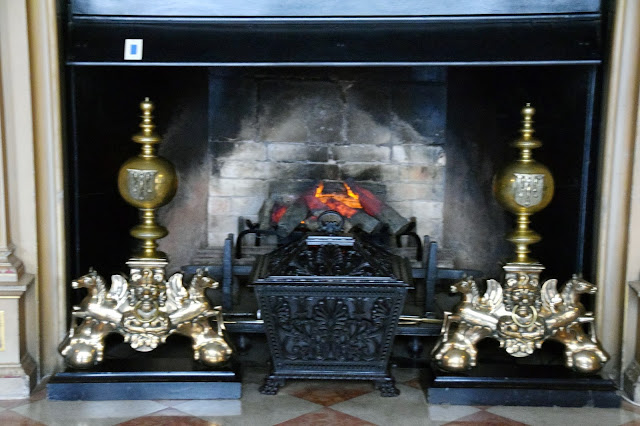Charlecote Park has been the home of
the Lucy family since the 13th century. It is a magnificent Tudor
mansion built by Sir Thomas Lucy on a level site beside the River Avon,
on the foundations of an even earlier medieval house.
Charlecote
Park is approached through a long path that leads under an impressive
Tudor brick gatehouse. Behind the house is a small formal garden
terrace, beyond which is a large deerpark designed by Capability Brown,
where a herd of deer still roam.
One of the most interesting features of Charlecote are the ornate Tudor chimneys (best viewed from the rear of the house). The house interior is largely Victorian, and visitors can go 'below stairs' to see what life was like for the servants who kept Charlecote running. There are numerous outbuildings on view, including a kitchen and cider press.
Queen Elizabeth I is known to have visited the house, and stayed in the chamber that now serves as the drawing room. A contemporary portrait of the queen is on view.
The Lucy family came to England as supporters of William the Conqueror, and the family has owned land at Charlecote since 1247. Sir Thomas Lucy (1532-1600), the builder of the current house, was a magistrate under Elizabeth I. In the course of his duties he was responsible for prosecuting local families with Catholic sympathies, including the Arden family, William Shakespeare's maternal grandparents.
Tradition says that William Shakespeare was once caught poaching deer on the Charlecote Estate. This tale may well be true, as the estate lies close to Shakespeare's family home at Stratford. The story goes that Shakespeare was forced to flee the area to avoid prosecution by Sir Thomas. The young playwright escaped to London, and the rest, as they say, is history. Shakespeare satirised Lucy by casting him as Justice Shallow in The Merry Wives of Windsor and Henry VI, part 2.
One of the most interesting features of Charlecote are the ornate Tudor chimneys (best viewed from the rear of the house). The house interior is largely Victorian, and visitors can go 'below stairs' to see what life was like for the servants who kept Charlecote running. There are numerous outbuildings on view, including a kitchen and cider press.
Queen Elizabeth I is known to have visited the house, and stayed in the chamber that now serves as the drawing room. A contemporary portrait of the queen is on view.
The Lucy family came to England as supporters of William the Conqueror, and the family has owned land at Charlecote since 1247. Sir Thomas Lucy (1532-1600), the builder of the current house, was a magistrate under Elizabeth I. In the course of his duties he was responsible for prosecuting local families with Catholic sympathies, including the Arden family, William Shakespeare's maternal grandparents.
Tradition says that William Shakespeare was once caught poaching deer on the Charlecote Estate. This tale may well be true, as the estate lies close to Shakespeare's family home at Stratford. The story goes that Shakespeare was forced to flee the area to avoid prosecution by Sir Thomas. The young playwright escaped to London, and the rest, as they say, is history. Shakespeare satirised Lucy by casting him as Justice Shallow in The Merry Wives of Windsor and Henry VI, part 2.
[ http://www.britainexpress.com/attractions.htm?attraction=3610]
[https://www.nationaltrust.org.uk/charlecote-park]
The 'new' Charlecote, completed by the first Sir Thomas Lucy in 1558
was one of the first great Elizabethan houses. His son, also Thomas,
married Constance Kingsmill who brought a dowry of £40,000 and,
ultimately, 14 children to Charlecote.
Sir Thomas III was a lover of culture – fond of music and theatre,
putting on performances in the Great Hall, and a friend of poet John
Donne. His wife Alice shared his love of books and her library was
renowned as it still is today.
Take a look at the family portrait over the fireplace in the Great Hall
which shows Sir Thomas III and Alice with seven of their 13 children.
There has been a fallow deer herd at Charlecote for centuries, and
legend has it that a young William Shakespeare was prosecuted for
poaching here
The house you see today at Charlecote was built in the 1550s, when the
estate lay at the southern edge of the ancient Forest of Arden. Over
time the landscape became more open as the trees were removed to create a
fashionable deer park.
Imagine filling the washing coppers with hot water and hauling out the
wet linen to dry – a tough job for the women, whether it was a hot
summer’s day or a chilly winter afternoon. In the tackroom you’ll see
the huge range of implements that were regarded as essential for
maintaining the family’s riding equipment, much of which has hardly
changed in the last century.
the
lives of Charlecote's servants in the immaculately-preserved
outbuildings and one of the best surviving Victorian kitchens in
Britain.
The comprehensive carriage collection of vehicles used by the Lucy
family will fascinate lovers of romantic historical fiction – here you
can compare the merits of a phaeton, a barouche or a brougham.
The historic fallow deer herd comprises all 4 colours of the species –
common, menil (the spots are more distinct than the common), melanistic
(very dark), and leucistic – almost white.
Charlecote's library is one of the finest in the National Trust's care
Mary Elizabeth and George Hammond Lucy wanted to make Victorian
Charlecote conform to their ideal of ‘Merrie England’ in the reign of
‘Good Queen Bess’. They spared no expense and spent lavishly on items
from the Fonthill Abbey sale of items from the dissolute William
Beckford.
Between 1823 and 1890 Mary Elizabeth Lucy embraced her life as Mistress
of Charlecote and it is the story of her life and that of her husband,
George Hammond Lucy, that you share in the house today.



















































































No comments:
Post a Comment